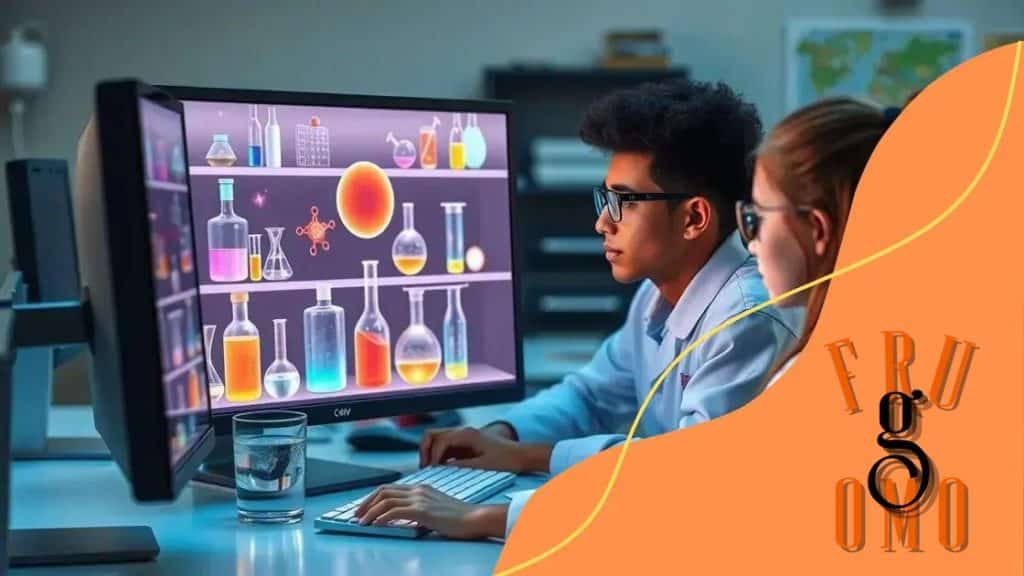Virtual labs in science education: revolutionizing learning

Virtual labs in science education provide immersive, interactive environments that enhance learning by allowing students to conduct experiments safely and collaboratively, utilizing advanced technologies like AI and VR.
Virtual labs in science education are transforming how students engage with scientific concepts. Have you ever wondered how these interactive environments can enhance learning experiences? Let’s dive into the world of virtual laboratories.
Understanding virtual labs
Understanding virtual labs is essential for modern education. These innovative tools allow students to conduct experiments in a simulated environment, enhancing their learning experience.
Virtual labs provide a safe and controlled space for students to explore complex scientific concepts. They can manipulate variables, observe outcomes, and learn from their mistakes without the risks that come with physical experiments.
What are virtual labs?
Virtual labs are online simulations that replicate real-world laboratory experiments. They integrate technology to create realistic scenarios where students can experiment and practice their skills. These labs are accessible from anywhere, making science education more flexible and inclusive.
Benefits of virtual labs
There are several advantages to using virtual labs in education:
- Increased engagement through interactive and immersive experiences.
- Accessibility for all students, regardless of location.
- Flexibility in learning, allowing students to experiment at their own pace.
Moreover, virtual labs can accommodate various learning styles, ensuring that each student can gain a deeper understanding of scientific principles. By encouraging exploration and curiosity, these labs enhance critical thinking and problem-solving abilities.
In recent years, the adoption of virtual labs has accelerated, especially with the rise of online learning. They offer an innovative solution that bridges the gap between theoretical knowledge and practical application.
Benefits of virtual labs in education
Benefits of virtual labs in education are numerous and transformative. These labs enhance learning experiences by providing interactive environments where students can experiment freely.
Access to virtual labs allows students to conduct experiments that might be too dangerous or costly in a traditional setting. This aspect encourages exploration and creativity, as students can try out different hypotheses without fear of failure.
Key advantages of virtual labs
Some primary benefits include:
- Flexibility: Students can access labs from anywhere, fitting their studies into busy schedules.
- Cost-effectiveness: Virtual labs often reduce the costs associated with physical lab setups and materials.
- Immediate feedback: Many virtual labs provide real-time data analysis, helping students understand results as they experiment.
In addition, virtual labs support various learning styles, accommodating visual learners with simulations and auditory learners through narrated guides. This adaptability promotes a deeper grasp of scientific principles.
Furthermore, these labs foster collaboration among students. Many platforms allow group experiments, where learners can work together, discuss findings, and share insights. Such teamwork skills are essential in today’s educational environment.
The convenience of virtual labs contributes to higher engagement levels. Students who may feel intimidated by physical labs often find comfort in an online environment. This fosters a positive attitude towards learning.
Key technologies behind virtual labs

Key technologies behind virtual labs play a crucial role in enhancing science education. These technologies enable realistic simulations and interactive experiments that bring concepts to life.
One of the most significant technologies is 3D modeling. It allows students to visualize complex structures and processes, making it easier to grasp challenging scientific ideas. With 3D modeling, learners can interact with elements in a way that a textbook simply cannot provide.
Use of simulation software
Another essential component is simulation software. This software emulates real laboratory conditions, allowing students to perform experiments virtually. It helps them develop practical skills and understand experimental procedures without real-world constraints.
Cloud-based platforms
Many virtual labs also utilize cloud technology. This feature ensures that students can access their labs from anywhere, which promotes learning flexibility. Collaborative tools enable students to work together on experiments, even if they are miles apart.
- Artificial intelligence: AI enhances personalized learning experiences by adapting to student performance.
- Data analytics: Analyzing student interactions helps educators tailor their teaching strategies.
- Virtual and augmented reality: These technologies immerse students in interactive environments, making learning more engaging.
Moreover, advancements in internet connectivity have made it possible for more students to utilize virtual labs. High-speed internet allows for seamless interaction with content, increasing the effectiveness of the learning experience.
As these technologies continue to evolve, the potential for virtual labs to transform education grows. They are no longer just an alternative; they are becoming a vital part of how we learn science.
Best practices for using virtual labs
Best practices for using virtual labs can significantly impact the effectiveness of science education. Implementing these practices helps maximize the benefits that virtual labs offer.
First, it’s essential to integrate hands-on experience with theory. Students learn best when they can apply what they have studied in a practical context. Using virtual labs in tandem with classroom instruction reinforces concepts and promotes deeper understanding.
Encouraging exploration
Encouraging students to explore different scenarios in virtual labs can lead to valuable learning experiences. Let them manipulate variables during experiments, which helps them understand cause and effect. This freedom nurtures curiosity and critical thinking.
Setting clear objectives
Before starting an experiment, define clear learning objectives. This step ensures that students understand what they should achieve. Having specific goals helps keep students focused and engaged.
- Utilizing feedback: Encourage students to review their results and reflect on what they learned.
- Collaborating with peers: Group projects can enhance teamwork and make learning more enjoyable.
- Regular assessments: Conduct quizzes or discussions to gauge understanding and reinforce learning.
Additionally, it’s important to provide ongoing support. Offering guidance through tutorials or resources can help students navigate virtual labs more easily. Ensure that help is readily available for any technical challenges they may encounter.
Lastly, continuously gather feedback from students. Understanding their experiences can help in adjusting methods for better outcomes. Engaging with students’ thoughts leads to improvements in how virtual labs are utilized in the educational setting, creating a more enriching environment for learning.
Future trends in science education
Future trends in science education are shaping how we learn and engage with scientific concepts. As technology advances, we can expect significant changes in classroom environments and learning methodologies.
One major trend is the increased use of artificial intelligence. AI can help personalize learning experiences, adapting to the individual needs and pace of each student. This technology will enable educators to provide tailored support, enhancing student understanding.
Integration of virtual reality
Another exciting trend is the integration of virtual reality (VR) in science education. VR allows students to experience immersive environments, exploring everything from the human body to distant planets. Such experiences can enhance engagement and retention of scientific knowledge.
Emphasis on collaboration
Collaboration will also play a critical role in the future of science education, with students often working together in online platforms to conduct experiments and share findings. This shift encourages teamwork and communication skills, which are essential in scientific research.
- Project-based learning: Students will engage in hands-on projects, applying theories to real-world problems.
- Interdisciplinary approaches: Science education will increasingly overlap with other subjects, promoting a more holistic understanding.
- Data literacy: As data becomes vital in science, teaching students to analyze and interpret data will be essential.
In technology-driven classrooms, access to real-time data will empower students to conduct experiments and analyze results instantly. This ability to adapt and experiment fosters a culture of inquiry and innovation.
As science education evolves, educators must embrace these trends and incorporate them into their teaching strategies. Keeping up with the latest advancements will better prepare students for future scientific endeavors and careers.
FAQ – Questions about Virtual Labs in Science Education
What are virtual labs?
Virtual labs are online simulations that allow students to conduct experiments in a safe, controlled environment, enhancing their understanding of scientific concepts.
How do virtual labs improve student learning?
They provide interactive experiences that engage students, allowing them to experiment and explore concepts without the risks of traditional labs.
What technologies are used in virtual labs?
Key technologies include 3D modeling, simulation software, and cloud platforms that facilitate access and collaboration.
What are the best practices for using virtual labs?
Effective practices include setting clear objectives, encouraging exploration, and providing ongoing support to maximize the learning experience.





